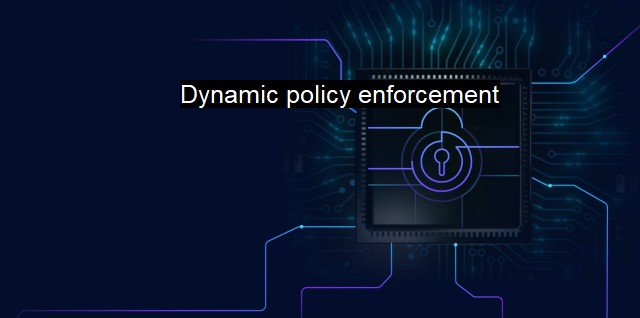What is Dynamic policy enforcement?
Proactive Cybersecurity: The Role of Dynamic Policy Enforcement and Antivirus to Mitigate Increasing Threats
Dynamic policy enforcement is a security approach grounded in the principles of always staying alert, vigilant, and active to prevent any possible threats that could potentially harm the digital systems and assets of an organization in the cyber realm. it suggests an operational conduct that dynamically alters and adapts according to threats detected to continuously maintain an optimum level of security.Unlike static security measures that function based on preconceived notion and remain unchanging, dynamic policy enforcement becomes stronger every time it encounters a threat. Static strategies although efficient in detecting and combating known threats, often struggle when it comes to handling novel viruses and newly emerged stealthy malware attacks as they only act according to the rules fed in prior. This incapacity is where dynamic policy enforcement excels.
Dynamic policy enforcement relies on behavior-based techniques to identify and respond to threats instead of signature-based techniques, which largely depend on identifying threats based on known patterns and data. The focus in dynamic enforcement is on the anomalous behavior which is a direct contrast to the static security protocol. dynamic policy enforcement does not stick to a given program but will adapt and change the security policy as per the prevailing conditions, akin to artificial intelligence system learning.
Throughout its operation, dynamic enforcement policies continuously learn, alter, and mature, contributing to their potency against ever-evolving threats. They scrutinize the ongoing operations in the infrastructure of an organization, continually learning to discriminate patterns that are regular and irregular. By overarching and learning from every interaction, it strengthens security by basing its data on actual tendencies rather than merely depending on documented threats.
Within such a design, if a user unknowingly opens a compromised attachment that contains a virus, the dynamic policy enforcement kicks in utilizing cognitive computing to validate the process causing the compromise. Based on this validation, the mechanism will deal with the threat appropriately. For instance, if dynamic policy enforcement is actively integrated with an antivirus system, it can identify malware behavior, isolate it, and in turn enrich the antivirus software’s capability to detect similar threats in the future.
Dynamic policy enforcement sees the gamut of potential threats as vast and varied. A significant aspect it takes into consideration are the internal threats i.e., threats caused by entities within the organization (unaware employees, disgruntled insiders, etc.). These issues are incredibly impactful when considering the rapid adoption of mobile computing, cloud services, and the Internet of Things (IoT) each generating a multitude of potential backdoors that can be exploited by cybercriminals. By employing dynamic policy enforcement, from handling sensitive data to deciding who gets network access, the process comprises hardening and routine internal compliance checks at all levels.
Emerging trends in espionage and sophisticated cyber-attacks call for a level of security that is sensitive to changes and adapts according to the mutations of the threat environment. By helping organizations dynamically interact with incoming threats, dynamic policy enforcement promises a secured infrastructure resilient to the malicious advancements in the cyberworld.
Lastly, it is essential to mention the seamlessness offered by the dynamic policy enforcement cybersecurity approach. From incorporating real-time data to adopting machine learning for better threat prediction and modifying the security architecture accordingly, the seamlessness comes along by assessing the growing threat landscape effectively.
Although no system can provide perfect security, the continuous learning and adaptation quality under dynamic policy enforcement significantly increases an organization's defenses better than a static model can. It adds value to the organization's risk management strategy and provides a robust shield against ever-evolving threats.

Dynamic policy enforcement FAQs
What is dynamic policy enforcement in cybersecurity?
Dynamic policy enforcement in cybersecurity refers to the practice of enforcing security policies in real-time, based on dynamic threat intelligence and contextual information. This allows organizations to adapt and respond to emerging threats, ensuring that their security posture remains effective and up-to-date.How does dynamic policy enforcement work in antivirus software?
In antivirus software, dynamic policy enforcement involves continuously monitoring system activity and scanning for potential threats. If a threat is detected, the software will dynamically enforce policies to mitigate the risk, for example, by blocking network traffic, isolating infected files, or terminating suspicious processes. This approach helps to minimize the impact of malware and other cyberattacks.What are the benefits of dynamic policy enforcement in cybersecurity?
Dynamic policy enforcement offers several benefits, including enhanced threat detection and response capabilities, improved compliance and risk management, and better overall security posture. By continuously adapting to changing threats, organizations can better protect their systems and data from a wide range of cyber threats.How can organizations implement dynamic policy enforcement in their cybersecurity strategy?
To implement dynamic policy enforcement in their cybersecurity strategy, organizations should first assess their security risks and identify areas where they need to improve their threat detection and response capabilities. They should then invest in cybersecurity tools and technologies that can support dynamic policy enforcement, such as next-generation antivirus software, intrusion detection and prevention systems, and network access control solutions. Finally, organizations should establish robust security policies and procedures that enable them to quickly respond to emerging threats and enforce policies in real-time.| | A | | | B | | | C | | | D | | | E | | | F | | | G | | | H | | | I | | | J | | | K | | | L | | | M | |
| | N | | | O | | | P | | | Q | | | R | | | S | | | T | | | U | | | V | | | W | | | X | | | Y | | | Z | |
| | 1 | | | 2 | | | 3 | | | 4 | | | 7 | | | 8 | | |||||||